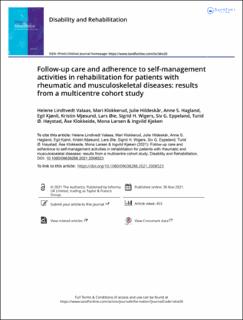| dc.contributor.author | Valaas, Helene Lindtvedt | |
| dc.contributor.author | Klokkerud, Mari | |
| dc.contributor.author | Hildeskår, Julie | |
| dc.contributor.author | Hagland, Anne Sirnes | |
| dc.contributor.author | Kjønli, Egil | |
| dc.contributor.author | Mjøsund, Kristin | |
| dc.contributor.author | Øie, Lars | |
| dc.contributor.author | Wigers, Sigrid Hørven | |
| dc.contributor.author | Eppeland, Siv Grødal | |
| dc.contributor.author | Høystad, Turid Østbøl | |
| dc.contributor.author | Klokkeide, Åse | |
| dc.contributor.author | Larsen, Mona | |
| dc.contributor.author | Kjeken, Ingvild | |
| dc.coverage.spatial | Norway | en_US |
| dc.date.accessioned | 2022-02-23T10:37:01Z | |
| dc.date.available | 2022-02-23T10:37:01Z | |
| dc.date.created | 2021-12-28T11:24:27Z | |
| dc.date.issued | 2021-11-30 | |
| dc.identifier.citation | Disability and Rehabilitation. 2021, . | en_US |
| dc.identifier.issn | 0963-8288 | |
| dc.identifier.issn | 1464-5165 | |
| dc.identifier.uri | https://hdl.handle.net/11250/2980969 | |
| dc.description.abstract | Purpose: Follow-up care (FU-care) and self-management are recognized as important to ensure prolonged effects of rehabilitation. Objectives of this study were to explore current FU-care and self-management after specialized rehabilitation for patients with rheumatic and musculoskeletal diseases. Materials and methods: This multicentre cohort study included 523 patients who self-reported need and plans for FU-care and plans for self-management activities (SMAs) at rehabilitation discharge. The FU-care received and adherence to SMA were self-reported after 4-, 8-, and 12-months. Predictors for received FU-care and adherence to SMA were explored in multiple logistic regression models. Results: Plans for FU-care were significantly associated with received FU-care. Younger age, better coping skills, and performing regular social activities and hobbies were significant predictors for received FU-care. Throughout the follow-up year, 221 (51%) participants had adherence to their SMA plans. Older age, regular physical activity, more severe pain, and performing regular social activities and hobbies were significant predictors for adherence to SMA. Participants with SMA adherence more often reported planned FU-care, and more frequently received the FU-care they needed. Conclusions: Planning FU-care should be integrated in specialized rehabilitation. Patients with poor coping skills and sedentary lifestyle may need more support over longer time to implement behavioral changes for healthy self-management.Implications for rehabilitationPlanning follow-up should be integrated in specialized rehabilitation as it supports self-management and receiving follow-up at home.Patients with sedentary lifestyle, poor coping skills, and depression may need more support over longer time to implement healthy self-management.Structure and routines in daily life enhance self-management. | en_US |
| dc.description.sponsorship | This multicentre cohort study was funded by Dam Foundation. | en_US |
| dc.language.iso | eng | en_US |
| dc.publisher | Routledge | en_US |
| dc.relation.ispartofseries | Disability and Rehabilitation; | |
| dc.rights | Attribution-NonCommercial-NoDerivatives 4.0 Internasjonal | * |
| dc.rights.uri | http://creativecommons.org/licenses/by-nc-nd/4.0/deed.no | * |
| dc.subject | Rheumatic diseases | en_US |
| dc.subject | Musculoskeletal diseases | en_US |
| dc.subject | Rehabilitation | en_US |
| dc.subject | Follow-up care | en_US |
| dc.subject | Self-management | en_US |
| dc.subject | Adherence | en_US |
| dc.title | Follow-up care and adherence to self-management activities in rehabilitation for patients with rheumatic and musculoskeletal diseases: results from a multicentre cohort study. | en_US |
| dc.type | Peer reviewed | en_US |
| dc.type | Journal article | en_US |
| dc.description.version | publishedVersion | en_US |
| dc.rights.holder | © 2021 The Author(s) | en_US |
| cristin.ispublished | true | |
| cristin.fulltext | original | |
| cristin.qualitycode | 1 | |
| dc.identifier.doi | https://doi.org/10.1080/09638288.2021.2008523 | |
| dc.identifier.cristin | 1972387 | |
| dc.source.journal | Disability and Rehabilitation | en_US |
| dc.source.pagenumber | 1-10 | en_US |

